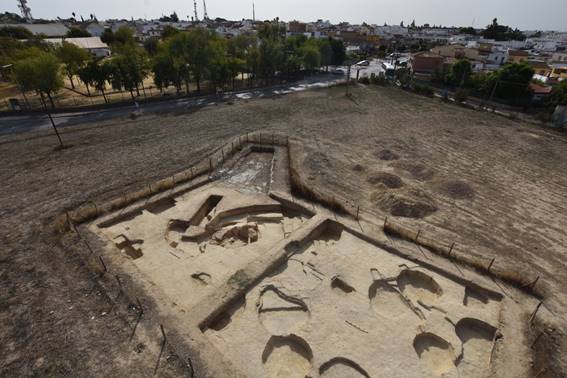Lista archport
Mensagem

[Archport] El "mega-site" de Valencina de la Concepción (Sevilla).
A ADECAP TEM O PRAZER DE ANUNCIAR A PALESTRA ABERTA, POR ZOOM NO Dia 22 de maio de 2024, 21,30 h. (hora de Portugal) Pelo Prof. Doutor Thomas X. Schuhmacher Deutsches Archäologisches Institut - Calle Serrano 159 - E-28002 Madrid e-mail: thomas.schuhmacher@dainst.org ORCID: 0000-0001-6735-1997 Link zoom para acesso à palestra: https://videoconf-colibri.zoom.us/j/98218370107
Sobre El “mega-site” de Valencina de la Concepción (Sevilla). Un poblado clave para entender las sociedades complejas calcolíticas [The 'mega-site' of Valencina de la Concepción (Seville). A key settlement for understanding complex Chalcolithic societies] Resumo da palestra: Desde 2014 el proyecto de investigación Valencina-Nord lleva a cabo investigaciones en el ›mega-site‹ de Valencina de la Concepción. Dichos trabajos incluyen prospecciones geo-físicas, prospecciones y excavaciones arqueológicas, o reconstrucciones paleoclimáticas, entre otros estudios (ceramológicos, líticos, metalúrgicos, etc.). Se ha podido detectar y datar un total de 11 líneas de fosos que delimitan el yacimiento formando un total de siete recintos, aparte de dos serpentiformes más, y se han excavado más de una treintena de estructuras de diversa tipología. Las cabañas y los talleres documentados junto con el material que en ellos aparece hablan a favor de una ocupación intensiva y continuada desde el Neolítico final/Calcolítico inicial (final del 4° milenio AC) hasta el final del Calcolítico hacia 2250 AC, experimentando su apogeo durante el Calcolítico pleno, alcanzando una extensión de unas 200 ha. A pesar de la reducción del poblamiento que tuvo lugar a partir segunda mitad del 3er milenio, siguen existiendo evidencias de la importancia, estratégica, comercial y política que tuvo la meseta aljarafeña a lo largo de la prehistoria reciente. Abstract in English: Since 2014, the Valencina-Nord research project has been studying the Valencina de la Concepción 'mega-site'. This work includes geo-physical and archaeological surveys and excavations, as well as paleoclimatic reconstructions, among other studies (ceramological, lithic, metallurgical, etc.). It has been possible to detect and date 11 lines of ditches that delimit the site, forming a total of seven circular enclosures, as well as two with serpentine ditches, and more than thirty structures of different types have been excavated. The documented huts and workshops together with the material found in them speak in favour of an intensive and continuous occupation from the Late Neolithic/Early Chalcolithic (end of the 4th millennium BC) until the end of the Chalcolithic around 2250 BC, experiencing its apogee during the full Chalcolithic, reaching an extension of some 200 ha. Despite the reduction in settlement that took place from the second half of the 3rd millennium, there is still evidence of the strategic, commercial and political importance of the Aljarafe plateau throughout recent prehistory. O autor: Thomas X. Schuhmacher, Doctor en Prehistoria (1998) por la Universidad Eberhard-Karl de Tubinga (Alemania). Habilitado para la enseñanza universitaria primero por la Universidad Otto-Friedrich de Bamberg (2005) y más tarde por la Universidad Julius-Maximilian de Würzburg (2018) donde actualmente es Profesor no Titular (Privatdozent). Ha realizado parte de sus estudios en las universidades Ludwig-Maximilian de Munich y la Universitat Autònoma de Barcelona y dado clases en las universidades de Tubinga, Heidelberg, Bamberg y Würzburg. Fue Profesor Asociado en el Departamento de Prehistoria y Arqueología de la Universidad Autónoma de Madrid (2012-2015). Fue asistente de investigación en el Instituto Arqueológico Alemán de Madrid para el proyecto del yacimiento argárico de Fuente Álamo (Almería) (1993-1996) y colaborador científico en el IAA para el proyecto de marfil prehistórico (2005-2012) y del poblado calcolítico de Valencina de la Concepción (2016-2021). Desde noviembre de 2021 es el responsable de Prehistória en el Instituto Arqueólogico Alemán de Madrid. El principal proyecto de investigación donde actualmente trabaja se centra en el Calcolítico, en Valencina de la Concepción (Sevilla, España) y desde hace dos años es también responsable de la investigación en el yacimiento calcolítico de Zambujal (Torres Vedras). About the author: Thomas X. Schuhmacher received his PhD in Prehistory (1998) from the Eberhard-Karl-University of Tübingen (Germany). Qualified for university teaching first at the Otto-Friedrich-University Bamberg (2005) and later at the Julius-Maximilian-University Würzburg (2018) where he is currently a non-tenured professor (Privatdozent). He has done part of his studies at the Ludwig-Maximilian University of Munich and the Universitat Autònoma de Barcelona and taught at the Universities of Tübingen, Heidelberg, Bamberg and Würzburg. He was Associate Professor in the Department of Prehistory and Archaeology at the Universidad Autónoma de Madrid (2012-2015). He was a research assistant at the German Archaeological Institute of Madrid for the Argaric site of Fuente Álamo (Almería) (1993-1996) and scientific collaborator at the IAA for the prehistoric ivory project (2005-2012). Since November 2021 he is head of Prehistory at the German Archaeological Institute in Madrid. The main research project where he is currently working focuses on the Chalcolithic at Valencina de la Concepción (Seville, Spain) and since two years he is also responsible for the investigation at the Chalcolithic site of Zambujal (Torres Vedras). Link zoom para acesso à palestra: https://videoconf-colibri.zoom.us/j/98218370107 |
| Mensagem anterior por data: [Archport] 21 maio 2024, 18h no Museu de Lisboa - Teatro Romano I Irisalva Moita - fotografias de viagem | Próxima mensagem por data: [Archport] 100 Anos IRISALVA MOITA_«Uma Mulher na Cultura de Lisboa» |
| Mensagem anterior por assunto: [Archport] Eça de Queiroz - A Relíquia e Olisipo | Próxima mensagem por assunto: [Archport] El culto a Juno Sóspita en el Lacio antiguo |

